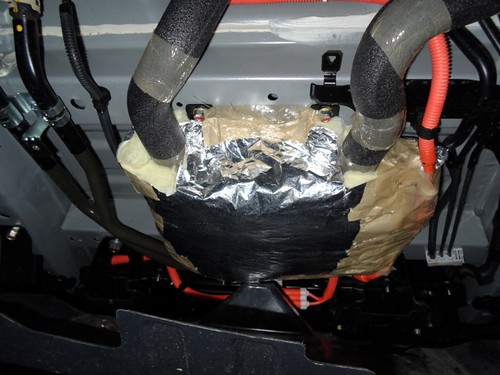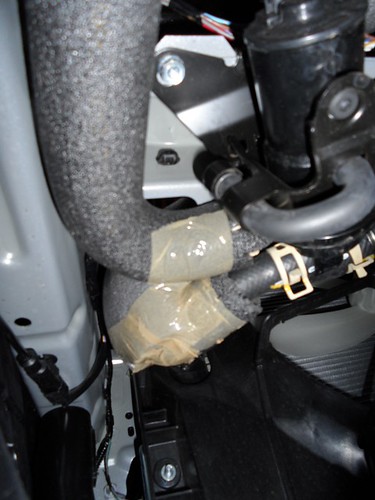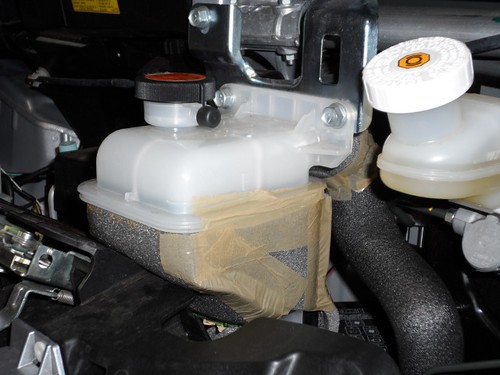sandange
Well-known member
Yesterday I went ahead and did the heater insulation,
My hands are about the size of bear paws so....
I took my Miev to my local mechanic and had him put it up on the lift. He got in those tight spots to insulate the pipes and I assisted.
Cooked up a little bit different method, using a combination of several materials
the ingredients.....
http://s211.photobucket.com/user/Sandange/slideshow/miev/Miev heater Insulation
Heat resistant, Aluminum, silicone tape and EPDM insulating tape
A roll of aluminum foil,
2" Dow corning C 200 heat resistant foam board for the box perimeter,
Low expansion Expanding foam spray can (for doors and windows) heat rated specs, for bottom and sides of the insulating box.
1/2" & 3/4" pipe sleeve insulation for pipes
Tie wraps
Plastic cover removed and heater exposed
Pipes insulated, Ridged Foam pieces cut fitted to create a border dropping below the heater about 3/4"
Heater is tightly wrapped with foil & wires were wrapped with tape to prevent spray foam from sticking to it.
Foam injected around the top and surrounding edges to envelope the heater and bond the foam together
A piece of foam board was cut to the act as a bottom lid and then lined with foil.
Spray foam was applied to the bottom of the heater and piled up on the foam lid like whipping cream ,
The lid was lifted into place and held there with the help of a jack, & we waited for it to harden.
This created a molded bottom layer of insulation of about 3/4" thick .
Once the foam set (About 15 minutes) we removed the foam board lid, the excess foam was trimmed off and the aluminum foil stayed in place stuck to the spray foam. The extra foil that was hang on the sides was used to wrap up on the sides of the heater.
Finally the plastic cover was reinstalled.
It took about 3 hours to do the job on a lift
My hands are about the size of bear paws so....
I took my Miev to my local mechanic and had him put it up on the lift. He got in those tight spots to insulate the pipes and I assisted.
Cooked up a little bit different method, using a combination of several materials
the ingredients.....
http://s211.photobucket.com/user/Sandange/slideshow/miev/Miev heater Insulation
Heat resistant, Aluminum, silicone tape and EPDM insulating tape
A roll of aluminum foil,
2" Dow corning C 200 heat resistant foam board for the box perimeter,
Low expansion Expanding foam spray can (for doors and windows) heat rated specs, for bottom and sides of the insulating box.
1/2" & 3/4" pipe sleeve insulation for pipes
Tie wraps
Plastic cover removed and heater exposed
Pipes insulated, Ridged Foam pieces cut fitted to create a border dropping below the heater about 3/4"
Heater is tightly wrapped with foil & wires were wrapped with tape to prevent spray foam from sticking to it.
Foam injected around the top and surrounding edges to envelope the heater and bond the foam together
A piece of foam board was cut to the act as a bottom lid and then lined with foil.
Spray foam was applied to the bottom of the heater and piled up on the foam lid like whipping cream ,
The lid was lifted into place and held there with the help of a jack, & we waited for it to harden.
This created a molded bottom layer of insulation of about 3/4" thick .
Once the foam set (About 15 minutes) we removed the foam board lid, the excess foam was trimmed off and the aluminum foil stayed in place stuck to the spray foam. The extra foil that was hang on the sides was used to wrap up on the sides of the heater.
Finally the plastic cover was reinstalled.
It took about 3 hours to do the job on a lift




